#longmen mountains
Explore tagged Tumblr posts
Text

Magikarp is one of the best Pokémon and doesn’t deserve all the hate it gets!
🐟🇨🇳🐉
#history#magikarp#dragon gate#gyarados#liyu tiao long men#mythology#chinese history#carp#game freak#emperor yu#kanto region#yellow river#video game history#pokemon#expression#longmen mountains#dragons#china#video games#sui dynasty#chinese mythology#exams#pokemon leafgreen#pokemon firered#medieval history#nickys facts
7 notes
·
View notes
Text
Cultural Architecture: NWT Totem Poles - The Specifics Pt. 2
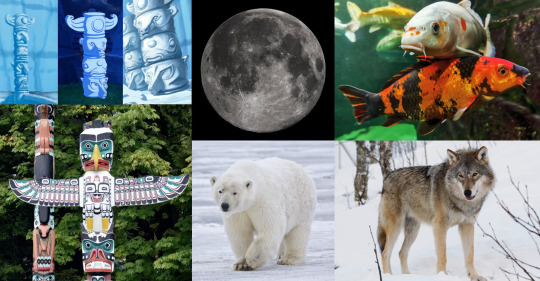
Among most of the totem poles we see throughout the Northern Water Tribe (NWT), four representations appear consistently throughout. For this post, I will be covering the final two.
Koi Fish
The third totem is clearly a koi fish with long whiskers and a marking on its forehead. In other words, it's a reference to the physical forms of the moon and ocean spirit. I can't help but wonder if Aang's realization of Tui and La's true forms was unconsciously informed by the all the koi head totems omnipresent throughout the NWT.
Culturally, koi fish are yet another example of the Chinese influence in the NWT. In Chinese culture, koi represent fame, family harmony and wealth. There's also a famous Chinese folktale about koi fish and other carp:
Along the Yellow River, there is a legendary waterfall that cascades from a magical mountain top known as Longmen (登龍門), meaning the Dragon's Gate. If a carp can swim upstream against the currents and hop over the waterfall into Longmen, the fish will transform into a dragon.
Thus, koi fish can also represent determination, courage, and perseverance. The connection between koi and dragons also strengthens the fan theory that the dragons Ran and Shaw might be the Fire Nation's equivalent to Tui and La. Perhaps the dragons are the spirit of Sun and Fire respectively?
Wolf
The totem beneath the koi depicts a wolf. The wolf head totem also bares a striking resemblance to the headdress that Sokka wears in "Day of the Black Sun" (Season 3, Episode 11). Wolves are prominent figures in the mythologies of many Indigenous American cultures, particularly those whose societies were oriented around hunting.
Within different Inuit groups, wolves are called amarok (multiple groups), amagok (Inuvialuit), and amaguk (Inupiat). These names refer both to normal wolves and to the gigantic, supernatural wolf of Inuit religion. There are two Amarok-focused tales that I'd like to detail in this post:
A persecuted and physically stunted boy seeks to increase his strength. When he calls out to the lord of strength, Amarok appears and wrestles him to the ground with its tail. This causes a number of small bones to fall from the boy's body. The Amarok tells the boy that the bones had prevented his growth; he instructs the boy to return daily in order to develop his strength. After several days of wrestling with the Amarok, the boy is strong enough to overcome three large bears, thus gaining him the esteem of his village.
The land was once full of caribou; the people lived well and were happy. But the hunters only killed those caribou that were big and strong. Soon all that was left were the weak and the sick. The people began to starve. And so they called upon Amorak, the spirit of the wolf, to winnow out the weak and the sick, so that the herd would once again be strong. The people realized that the caribou and the wolf were one, for although the caribou feeds the wolf, it is the wolf that keeps the caribou strong.
From these two stories, we get quite a nuanced conception of what the wolf represents in Inuit culture. While wolves represent strength in many cultures, these tales really emphasize the wolf as a creature that strengthens those around it. Through this worldview, we understand strength not as an innate or individualistic quality, but one that's nurtured through mentorship and interdependence.
This makes Sokka's adoption of wolf imagery during "Day of Black Sun" all the more appropriate. Sokka is certainly not the most powerful character in the show, but his role as the leader strengthens the group as a whole.
Like what I’m doing? Tips always appreciated, never expected. ^_^
https://ko-fi.com/atlaculture
330 notes
·
View notes
Text
The tale of Longmen or of the Dragon Gate is primarily a Chinese myth, but it has been embraced by the Japanese as well.
It's a proverbial idiom. The rising one's self higher through trial and effort. A carp swimming up a waterfall to pass through the dragon's gate, becoming something powerful and noble. It was meant to inspire students.

The history is fascinating because the legend says Yu the Great cut through the mountain causing a flood that swept the silver carp down stream where they complained to Yudi the Jade Emporer who told them that if they could swim up the waterfall they would be turned into dragons. The few that managed turned into dragons the second they passed the gate and flew away.

Of course, in Japan some of these details have changed, but all the same...
Magikarp is "useless" (It is one of my favorite pokemon and I will refrain from arguing about how it is, in fact, very cool)
Gyarados is only useless in the meta, but it sure has a bitchin' design, no?
There is no toxin here, only hope. Your racism is showing, my friend.

16 notes
·
View notes
Note
Name suggestion for the new holders:
Rat trap for Nino,it means rat trap lol,btw,trap is also a music genre and sound/hearing is a way to perceive the world.
Dean's boar/beast/bacon for Felix,the Beast of Dean is folkloric animal said to live or once lived,in the Forest of Dean,Gloucestershire,England
Susincultus for Felix,it comes from Latim,incultus means:neglect, lack of cultivation, lack of refinement, want of attention, disregard, ignorance,and sus means:sow, pig, swine, hog, boar, kind of fish
Zhēnzhū for Zoé,so the surname lee have 3 origins one from Chinese(plum or plum tree),Korean(same as chinese) and old English(a forest clearing or meadow),all of them have a reference to nature, zhēnzhū means pearl
Dragon gate for Zoé,another reference to China,dragon gate/longmen is located at the top of a waterfall cascading from a legendary mountain,the legend states that while many carp swim upstream against the river's strong current, few are capable or brave enough for the final leap over the waterfall,if they sucessfully jump,the carp is transformed into a dragon
Wyvern for Zoé,wyvern is type of dragon
Nidhogg for Zoé, Nidhogg is dragon from norse mythology who gnaws at a root of the world tree,Yggdrasil,but he get his "redemption" after the Ragnarok(the end of the world in norse mythology),lifting the bodies of the righteous rulers so that they can dwell in Gimle
Imoogi for Zoé,is from korean mythology and is a hornless ocean dragon, sometimes equated with a sea serpent,imoogi literally means, "Great Lizard",the legend of the Imoogi says that the sun god gave the Imoogi their power through a human girl, which would be transformed into the Imoogi on her 17th birthday,legend also said that a dragon-shaped mark would be found on the shoulder of the girl, revealing that she was the Imoogi in human form
Jayeon jeongsin for Zoé,i swear it's the last one,it means "nature spirit" in Korean
That's a lot of suggestions for Zoe, but I will say, I'm likely to go with Wyvern as I have something of a design in mind for her.
The other two, we'll see
5 notes
·
View notes
Text
Annals of Emperor Wen of Zhou, 537
[Showdown at Shayuan. Arguably among the more iconic battles in Chinese history.]
[Datong 3, 27 January 537 – 14 February 538]
3rd Year, Spring, 1st Month [27 January – 24 February], Eastern Wei robbed Longmen, stationed an army at Puban, and built three roads and floating bridges to cross the He. Also they dispatched their general Dou Tai to press on to Tong Pass, and Gao Aocao to besiege Luo province. Taizu set out with the army for Guangyang, and summoned the various generals, saying:
The traitors are now gripping us on three sides, and are also building bridges on the He, showing their intention is surely to cross. With this they intend to bind up our army and make Dou Tai manage to go west and enter, and that is all. To grapple with them for a long time when their strategy is to obtain a march is not a good plan.
Moreover, since Huan raised troops and onwards, Tai has always been the first to chase ahead, and among his subordinates are many honed soldiers, frequently victorious and therefore self-assured. Now [if we] set out for where he does not expect, when we assault him we will surely overcome. If we overcome Tai, Huan will not fight but flee on his own.
Everyone of the various generals said:
The traitors are nearby. To let go of them and launch a far-away assault, if the affair turns out a blunder, regrets will not be enough.
Taizu said:
When Huan earlier twice assaulted Tong Pass, our army did not go beyond Bashang. At present when he comes in great number, the troops have not yet set out from the suburbs. The traitors look back and say we only defend ourselves and that is all, and have no thoughts of distant struggles. And also, accustomed to obtaining their aspirations, they have made light of our hearts. [If we] exploit this and strike them, where would we go and not overcome. Even though the traitors are constructing bridges, they will not be able to cross over straight-away. That within five days we will defeat Dou Tai is certain. Your Excellencies must not doubt it.
On gengxu [9 February], Taizu led 6 000 cavalry to return to Chang'an, and publicly talked of his intention to protect Longyou.
On xinhai [10 February], he paid his respects to the Emperor and then secretly set out with the army.
On guichou [12 February], he arrived at the Xiao Pass. Dou Tai's troops heard that the army had arrived, and were nervous and afraid. They took refuge in the mountain to make their battle line, but had not yet managed to complete their deployment when Taizu let loose the troops to strike and route them, fully taking prisoner their multitude of more than ten thousand people. He beheaded Tai and transmitted the head to Chang'an.
Gao Aocao just then captured Luo province and seized the Inspector, Quan Qi. He heard of Tai's death, burnt the supply wagons, abandoned the city, and fled. Shenwu of Qi likewise removed the bridges and withdrew. Qi's son Yuanli soon after restored Luo province, and beheaded the Eastern Wei Inspector, Du Mi. Taizu returned with the army to Chang'an.
6th Month [24 June – 22 July], dispatched the Ceremony Similar Yu Jin to defeat Yangshi Ramparts.
Taizu requested to lay down Acting Tribunal. The Emperor again repeated his previous instructions. Taizu accepted Recording the Affairs of the Masters of Writing, the remaining he firmly declined. He therefore desisted.
Autumn, 7th Month [23 July – 21 August], summoned the troops to assemble at Xianyang.
8th Month, dingchou [4 September], Taizu led Li Bi, Dugu Xin, Liang Yu, Zhao Gui, Yu Jin, Ruogan Hui, Yi Feng, Liu Liang, Wang De, Houmochen Chong, Liu Yuan, and Daxi Wu, twelve generals, on an eastern offensive. They arrived at Tong Pass, and Taizu then made an oath to the regiments, saying:
You and I are a multitude that serves Heaven's authority and executes the brutal and unruly. Indeed you gentlemen, orderly with your armour and arms, taking precautions with your military affairs, have no greed for wealth with which to make light of the enemy and no violence against the people with which to play the tyrant. Follow the instructions and be rewarded, do not follow the instructions and be humiliated. You multitude gentlemen should make an effort of it.
He dispatched Yu Jin to stay in front of the army and patrol the land until Pandou. The Eastern Wei general Gao Shuli defended the palisades and did not come down. Jin relentlessly attacked him, and he therefore surrendered. They captured 1 000 soldiers from his defence post and sent off Shuli to Chang'an.
On wuzi [15 September], they arrived at Hongnong. Eastern Wei's general Gao Gan and Inspector of Shan陜 province, Li Huibo, resisted and defended. At that time it rained continuously, and Taizu therefore instructed the various armies to dare the rain and attack them.
On gengyin [17 September], the city collapsed. He beheaded Huibo and captured 8 000 of his fighting soldiers. Gao Gan fled across the He. He ordered Heba Sheng to pursue and seize him, and sent off both to Chang'an.
Hence Yiyang and Shao commanderies both came to revert to adherence. Prior to this, many of the prominent and outstanding South of the He assembled troops in response to Eastern. Arriving at this point, each led their sections to come and surrender.
Shenwu of Qi was afraid, and led a multitude of 100 000 to set out from Hukou and hurry to Puban, wanting to cross over from Houtu[?]. He also dispatched his general Gao Aocao with 30 000 men to set out from South of the He. This year there was famine in Guanzhong. When Taizu had pacified Hongong, he lodged and foraged for more than fifty days. At the time his fighting soldiers were not fully 10 000 men. When he heard that Shenwu of Qi was about to cross, he therefore pulled in the army and entered the Pass.
Shenwu of Qi thereupon crossed the He and pressured Hua province. The Inspector, Wang Pi, rigourously defended. He understood he could not be attacked and therefore forded the Luo. The army was west of Xuyuan.
Taizu occupied South of the Wei, and levied the provincial troops which had not yet assembled. He then summoned the various generals and spoke to them, saying:
Gao Huan went past the mountains and crossed the He, coming from far-away to arrive here. It is the time for Heaven to undo him. I intend to strike him what should [I] do?
Everyone of the various generals considered the multitude too few in number amd would not resist. They requested to wait for Huan to once more go west, and so observe his circumstances. Taizu said:
If Huan manages to arrive at Xianyang, people's feelings will turn to agitation and confusion. Now when he is newly arrived, we can expediently strike him.
He promptly constructed floating bridges on the Wei, and ordered the army people to furnish three days of provisions. The light cavalry crossed the Wei while the supply wagons from South of the Wei clung to the Wei and [went?] west.
Winter, 10th Month, renchen [18 November], he arrived at Shayuan, the distance to Shenwu of Qi's army was about 60 li. Shenwu of Qi heard that Taizu had arrived, and pulled the army to come and meet him.
On guisi [19 November], dawn, scout cavalry reported Shenwu of Qi's army was about to arrive. Taizu summoned the various generals to plan with them. Li Bi said:
The others are many and we are few, it is not possible to set up the battle line on level ground. Ten li east of here there is a bend in the Wei. We can occupy it first and wait for them.
Thereupon they advanced the army to arrive at the bend in the Wei, and with the river behind them to the east and west they made their battle line. Li Bi had the right formation, and Zhao Gui the left. They instructed the generals and soldiers to lay down their glaives within the reeds and rushes, and when they heard the sound of drums to then rise up.
Yu Jin and others with the Six Armies joined battle with them, while Li Bi and others led the iron cavalry to strike them from the side. They broke their army into two units and greatly routed them. The beheaded counted more than 6 000, and those approached the battle line to surrender more than 20 000 people. Shenwu of Qi escaped in the night. They pursued until the banks of the He, and repeatedly greatly vanquished and captured. From beginning to then they took captive 70 000 of his soldiers. They kept behind 20 000 of his armoured soldiers, the reminder were fully set free to return home. They gathered up their supply wagons, arms and armour, and presented the prisoners at Chang'an.
He turned back the army to South of the Wei, and then the troops which had been levied from the various provinces started to arrive. Therefore at where the battle took place, he measured the [number of] soldiers at that time, and for [each] person planted a single tree as a symbol for their martial merit.
Advanced Taizu to Pillar of State Great General, and increased his estate, together with the previous, to 5 000 households. Li Bi and others, the twelve generals likewise were advanced in feudal rank and increased their estates. And also their subordinate generals and soldiers were each rewarded proportionally.
Dispatched the Archer-Servant of the Left, the King of Pingyi, Yuan Jihai, as Acting Tribunal. He and the Opening Office Dugu Xin led 20 000 infantry and cavalry towards Luoyang. The Inspector of Luo province, Li Xian, hurried toward Jing province.
Heba Sheng and Li Bi crossed the He to besiege Puban. The Commander of the Serrated Gates, Gao Zixin opened the gates and admitted Sheng's army. The Eastern Wei general Xue Chongli abandoned the city and fled. Sheng and others pursued and captured him. Taizu advanced the army to Puban, and seized and settled Fen and Jiang 絳. Hence Xu He killed Zhang Qiong and used Xia province to surrender.
Earlier, after Taizu had entered the Passes from Hongnong, the Eastern Wei general Gao Aocao besieged Hongnong. When he heard their army had been defeated, he withdrew to defend Luoyang. Dugu Xin arrived at Xin'an, and Aocao again fled across the He. He thereupon entered Luoyang.
Eastern Wei's Senior Clerk of Yingchuan, Heruo Tong, together with a native of Mi county, Zhang Jian, apprehended the Inspector, Tian Xun, and offered up the city in surrender. Zheng Rongye, Zheng Wei, and others of Xingyang attacked Liang梁 province, and seized its Inspector of Lu Yongji. Cui Yanmu and Tan Chen, natives of Qinghe, attacked Xingyang, and seized its commandery warden, Su Ding, all of them came to adhere. From Liang, Chen, and westwards, generals and magistrates who surrendered followed after each other.
Hence the Eastern Wei generals Yao Xiong, Zhao Yu, and Shiyun Bao set out for Yingchuan, intending to restore the surrendered territory. Taizu dispatched the Ceremony Similar Yuwen Gui, Liang Qian, and others to confront and strike, they greatly routed them. Zhao Yu came to surrender. Eastern Wei again dispatched general Ren Xiang to lead the troops from South of the He and combine with Xiong. The Ceremony Similar Yi Feng together with Gui, Qian, and others again struck and routed him. Also dispatched Chief Controller Wei Xiaokuan to capture Yu province. Shiyun Bao killed their Inspector of Dongyang province, Na Chun, and used the province to come and adhere.
4 notes
·
View notes
Text

(Image description: the opening paragraph of the Wikipedia page for "Longmen (mythology)", which reads: "In Chinese mythology, Longmen (lit. 登龍門 "Dragon Gate") is located at the top of a waterfall cascading from a legendary mountain. The legend states that while many carp swim upstream against the river's strong current, few are capable or brave enough for the final leap over the waterfall. If a carp successfully makes the jump, it is transformed into a powerful dragon.[1] The legend is so famous that throughout China, a common saying is that "a student facing his examinations is like a carp attempting to leap the Dragon Gate."")
69K notes
·
View notes
Text

9/26/23: r/SketchDaily theme, "Folktale Week: Doors & Gates." I Googled "gate folklore" and the top result was a charming Chinese myth illustrating the payoff of diligent work, featuring carp that, if they swim up a mountain waterfall and jump the top, known as the Dragon Gate, they turn into dragons and fly off into the air. Much art of this legend depicts no gate, so I assume this is simply the term for the top of the waterfall that must be jumped.
Longmen (mythology).
[Folktale Week: Doors & Gates [Tuesday, September 26, 2023, 2:00:55 AM]]
1 note
·
View note
Photo

2 notes
·
View notes
Text
Longmen Grottoes
Longmen Grottoes (World Cultural Heritage, China AAAAA-level tourist attraction)
The Longmen Grottoes are the treasure house of stone carving art with the largest number of statues and the largest scale in the world. It has been rated as "the highest peak of Chinese stone carving art" by UNESCO and ranks first among the major grottoes in China. Unit, AAAAA-level tourist attraction. (14 main attractions)
The grottoes in the Longmen area were first excavated in the Northern Wei Dynasty, flourished in the Tang Dynasty, and finally in the late Qing Dynasty. After more than 10 dynasties, including Northern Wei, Eastern Wei, Western Wei, Northern Qi, Sui, Tang, Five Dynasties, Song, Ming, and Qing Dynasties, it has been built for more than 1,400 years. It is the longest grotto in the world. Among all the caves in Longmen, about 30% of the caves in the Northern Wei Dynasty, 60% in the Tang Dynasty, and only about 10% in other dynasties.
After research, it was found that the Longmen Grottoes were built by Tianzhu (now India), Silla (now South Korea), Tocharo (Siberia), Kanguo (Central Asia) and other countries, and now they have found Western musical instruments, European patterns, ancient Greek stone pillars, etc. The extraterritorial elements are the product of the fusion of diverse civilizations such as Greece, Persia, India and China, and can be called the most internationalized grotto in the world.
Geographical environment
The Longmen Grottoes are located in the southern suburb of Luoyang, the ancient capital. The two mountains face each other, the Yishui River flows, the Foguang Mountains are beautiful, and the scenery is beautiful.
Longmen, also known as Yique, is where the east and west mountains face each other, and the Yihe River flows through it. From afar, it looks like a natural gate, so it was called "Yique" in ancient times.
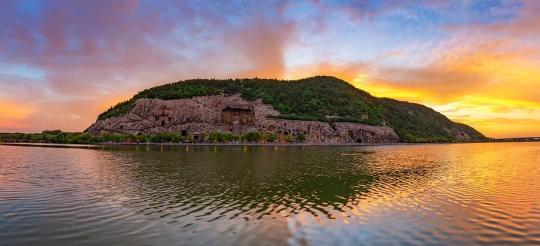
Longmen Landscape

Longmen Yique
Statue of the Locanabuddha

Locanabuddha
Buddha statues: a total of nine bodies. The main Buddha in the middle is the Great Buddha of Lusena, carved by Wu Zetian according to his own appearance and manners. On the right is the eldest disciple Kasyapa, on the left is the younger disciple Ananda, and then is Samantabhadra Bodhisattva (left) and Manjusri Bodhisattva (right). The heroic and vigorous king, the aggressive warrior and the master Flushena together constitute a group of artistic group images with rich modal texture.
Lord Buddha: Locanabuddha is the Sambhogakaya Buddha, which means the light shines all over the place. The height is 17.14 meters, the head is 4 meters high, and the ears are 1.9 meters long. It is famous for its mysterious smile and is praised as "Oriental Mona Lisa" and "the most beautiful statue in the world" by foreign tourists. The Buddha statue has a plump and round face, wavy hair lines on the top of the head, eyebrows curved like a crescent moon, with a pair of beautiful eyes gazing down slightly, showing a peaceful smile, like a wise and kind middle-aged woman, which is respectable and not afraid.
Samantabhadra Bodhisattva, the free translation of Sanskrit Samantabhadra, has also been translated as Banji Bodhisattva, and transliterated as Sanmando Bhadra. Samantabhadra Bodhisattva is one of the four bodhisattvas of Chinese Buddhism. It symbolizes virtue and conduct, and corresponds to Manjushri, who symbolizes wisdom and virtue. He is also the left and right attendant of Sakyamuni Buddha. In addition, Vairocana Tathagata, Manjushri Bodhisattva, and Samantabhadra Bodhisattva are honored as the "Three Saints of Huayan".

On the left is the "Tang Dynasty After the Journey" drawn by Zhang Xuan in the Tang Dynasty. Wu Zetian carved the Lushena Buddha in the Longmen Grottoes according to his own appearance.

Binyang South Cave
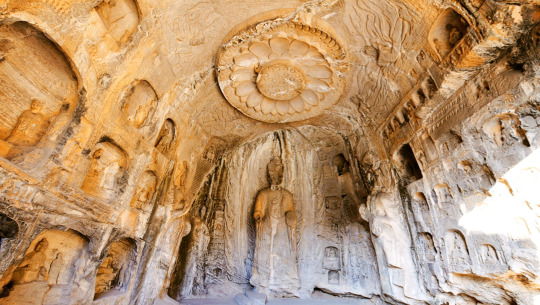
Lotus Cave
Value influence: The lotus dome of the Great Hall of the People is designed based on this lotus.
The smallest Buddha statue in the Longmen Grottoes is only 2 centimeters high. These small thousand Buddhas are located above the south wall of the Lianhua Cave, which are vivid, detailed and lifelike.

Xiangshan Temple

Digital restoration
2 notes
·
View notes
Text
I have no idea what is my mind going to tell me: I could end up talking about wild pterodactyls, or about those damned Missipipì hillbillies.
I know, Missipipì doesn’t exists, but the sentence wasn’t even mine!
Anyway, let us proceed.
How do you think a sport car driver must feel, as he races at 200 miles per hour on the asphalt? And what about high jumpers, who appear so towering?
How does a seagull feel as it flies too close to the water?
Why do cells multiply by dividing themselves?
I would really like to ride a camel on the legendary desert where everything is possible, but also on the mountains that detach you from every problem with their thick white fog.
Trust me when I tell you how a snake made turned being armless into a harmless form of art, and that the willow weeps because it’s simple to become sad when leaves turn dry and let themselves be carries away by the wind.
What about following me on a hot air balloon and land near the Longmen grottoes?
That said, I proceed typing without order on my dark computer keyboard, so that I could produce the necessary words that could conclude this, of which no one felt the need.
10 notes
·
View notes
Text



Longmen Mountain Dew
1 note
·
View note
Text
If Terra is supposed to be some kind of alternate earth, then I tried to guess what the locations/organisations are supposed to represent. The races, too, seem to be a different name of ‘[animal kind] people’. (These are just my personal interpretations though)
Organisations
Rhodes Island - Knights Hospitaller. Started out as a medical crusader order but was forced to adapt and refocus to militarised force - interestingly when people started to call the order ‘Knights of Rhodes’.
Penguin Logistics & BlackSteel - Both international trading companies everywhere and nowhere. Don’t seem to be representative of a specific country.
Rhine Lab - Probably originates in countries representative of Western Europe. The Rhine flows through Switzerland, Liechtenstein, Austria, Germany, France and the Netherlands.
Reunion - Modern terrorism.
Locations
Chernobog - Moscow? Either way, it’s a large city in Ursus. Ursus is said to have ‘large territory and fierce military might’. It is also the place where the bear people we know are from, also called Ursus (ursus is Latin for bear and the bear is Russia’s national animal)
Lungmen - Shanghai. It’s a large city and a huge one in terms of international trade, it’s also a port iirc. Lungmen is originally named 龍門 (Longmen), which is also the name of a county in Guangdong.
Victoria - United Kingdom. I don’t know if I should explain this because this one is p straightforward. The group Siege leads is even called Glasgow, sharing a name with the Scottish capital. Cat people from here.
Londinium - London. The name the Romans used for London is Londinium. I have no idea what Lentinium could be although it’s probably representative of another place in England.
Kazimierz - Could be Poland. Horse people from here.
Kjerag - Himalaya. Snow leopard people are from here, as well as people who are half Himalayan animal. The country is known for its snow-covered mountains.
Laterano - the Vatican. Angel people are from here. There’s even the Lateran council.
Rim Billiton and Columbia - seem to have inherited parts of the US? Dunno how to put this. Rim Billiton is Rabbit people place and Columbia is the place of the bird people; doves - Columbidae, although fox people also live here.
Far East - Seems to be Japan. Fumubuki is mentioned to be from here, as well as the Oni - in contrast to Wei Yenwu - for those not knowing, Fumubuki is a Japanese name while Wei Yenwu is a Chinese name.
Leithanien - Iceland.
Syracusa - Italy. Wolf people place.
Minos - Greece
Races
Anaty - Weasel/stout/ferret people.
Anura - Frog people. Frog = Anura in Latin. Same name as the real life thing.
Archosauria - Crocodile people. Representative of the Archosaurs are birds and crocodiles. Almost the same name as the real life thing.
Aslan - Lion people. Aslan (of Narnia fame) is Turkish for Lion.
Caprinae - Goat people. Same name as the real life thing.
Cautus - Bunny people.
Chimera - Straightforward.
There seems to be a distinction between Dragon and Drake - Dragon is Eastern, Drake is Western.
Durin - Dwarfs/gnomes.
Elafia - Deer people. Elafia is deer in Greek.
Feline - Cat people. Straightforward. Apparently also includes snow leopard people, chinese lion people (see Aak) and tiger people (see Waai Fu).
Forte - Bovine people. Forte = strength.
Itra - Musk deer people. Possibly from Arabic عطر ('itr) meaning 'perfume' or 'musk'
Kuranta - Horse people.
Liberi - Bird people. Liberi means free.
Lupo - Wolf people. Lupus means wolf in Latin.
Manticore - Straightforward.
Oni - Demon people. Seem different from Sarkaz though; they can have either a single horn (like a unicorn) or two.
Perro - Dog people. Perro means dog in Spanish. (I know this because a former classmate had a dog named Perro...) Seem to be from alternate South America and Spain. (see Dobermann)
Petram - Seem to have something to do with stone. Might be turtle people.
Rubeba - Hyena people.
Sarkaz - Horned demon people. Usually have two horns. Vampires are a subrace of them (see Warfarin).
Sankta - Angel people. Sankta = sanctus = holy in Latin.
Savra - Lizard people. Savra is Greek for lizard.
Ursus - Bear people. Like I said before, ursus = bear in Latin.
Vouivre - Wyvern people. Vouivre is wyvern in French.
Vulpo - Fox people. Vulpecula = little fox in Latin.
Zalak - Rat/Squirrel/Capibara people.
79 notes
·
View notes
Note
Hm.... i assumed the events on the mountain occured later but. Looking at the consequences of the Doctor's potential involvement (regent seizing Theresa's place, SilverAsh ascension, potentially also Victoria's current situation) it seems Doctor's actions were aimed at or their aim required upsetting the status quo in the world.
It’s damn hard to place the relative timeline of anything of these things, especially since most of the archive files are recent era with the new Doctor, but for Silverash his connection to the old Doctor sort of requires that it to be the case.
I agree, there’s a startling trend in political manipulation of national leaders and interests around that time. Kazdel, Kjerag, Victoria, even Ursus as we hear offhand about Talullah’s assassination of Duke Koschei; and with Wei Yenyu’s own ruthless political machinations and use of Reunion’s threat as a way to show Longmen’s power forming the bulk of the contemporary EN plot, there’s little doubt that the state of nations is going to continue to be important.
Interestingly these all basically amount to one trend; the destruction of hereditary monarchy and the installation of newer leaders with modern thinking. The thing is... most of these leaders that have been installed are violent chaos actors that have thrown their countries into disarray. Kazdel’s nomad culture has been overtaken by a united military, Victoria was thrown in riots and lawlessness with street gangs filling the gap, Kjerag being violently overthrown by a private corporate party.
Ursus is less clear, but we do know from the USU that there’s a first wave anti-tsarist communist revolution underway and that the government has been severely weakened and infiltrated by Reunion agents through Talulah’s influence...
Crazy stuff. Really begs the question of whether this truly is just a series of power grabs by warmongers and ambitious would-be leaders, or if the Doctor and Babel’s plans had something to gain from this.
13 notes
·
View notes
Text
The Water Classic, Part 1
[This is the core Classic only, i.e. without the Commentary, however the headings, SJZ01, SJZ02, etc., indicates the corresponding scrolls within the much longer Commentary on the Water Classic.]
[The maps are primarily intended to illustrate the Classic. Place names have as far as possible been placed in accordance with the Historic Atlas of China, and the rivers drawn as straight lines between their closest vicinity to each place. The Classic is not error-free, as is made clear in the Commentary. Unless noted otherwise, discrepancies between the Atlas and the Classic have been resolved in favour of the Atlas. Cities, mountains, rivers and other features not in the Atlas have been placed by me to fit the description in the Classic.]
SJZ01
Kunlun Barrens崑崙墟 are to the north-west, the distance to the Song Heights嵩高 is 50 000 li, it is at the centre of the land. Its height is 11 000 li.

He River河水 sets out from their north-eastern corner, bends to flow south-east from them, and enters the Bo Sea渤海. Again it sets out outside the sea, and to the south arrive below Jishi Mountain積石山 which has the Stone Gates石門 [shimen].
SJZ02
Again south it enters Congling Mountain蔥嶺山, again it sets out from Congling蔥嶺 and then flows north-east. One of its sources sets out from a mountain south of Yutian State于闐國, flows north and combines with the He河 that sets out from Congling蔥嶺. Again it east it pours into the Puchang Sea蒲昌海. Again east it enters the Frontier, and passes south of Dunhuang敦煌, Jiuquan酒泉, and Zhangye Commanderies張掖郡, again east to pass north of Longxi's隴西 Heguan County河關縣.


Tao River洮水 comes flowing from the south-east to pour into it, again east to pass north of Jincheng's金城 Qianya County允吾縣, again east to pass north of Yuzhong County榆中縣, again east to pass the northern boundaries of Tianshui天水, again north-east to pass east of Wuwei's武威 Aowei County媼圍縣, again north-east to pass north of Tianshui's天水 Yongshi County勇士縣, again north-east to pass Maitian Mountain麥田山 at the northern boundaries of Anding安定.
SJZ03
Again north to pass west of Beidi's北地 Fuping County富平縣.

Again north to pass west of Shuofang's朔方 Linrong County臨戎縣, bends north-east from the county, arrives west of Hemu County河目縣, bends south to pass south if Wuyuan's五原 Xi'anyang County西安陽縣, bends east to pass south of Jiuyuan County九原縣, again east to pass south of Linwo County臨沃縣, again east to pass south of Yunzhong's雲中 Zhenling County楨陵縣, again east to pass north of Sha'nan County沙南縣, from east of the county bends south to pass west of Shaling County沙陵縣, again south to pass east of Chi City赤城, again south to pass west of Dingxiang's定襄 Tongguo County桐過縣, again south to pass east of Xihe's西河 Yinyang County圁陽縣.

Again south to pass west of Lishi County離石縣, again south to pass west of Zhongyang County中陽縣, again south to pass Tujun County土軍縣, again south to pass east of Shang commandery's上郡 Gaonu County高奴縣.
SJZ04
Again south to pass west of Hedong's河東 Beiqu County北屈縣, again south to pass west of Pishi County皮氏縣, again south to set from Longmen Mouth龍門口, Fen River汾水 comes from the east to pour into it, again south to pass west of Fenyin County汾陰縣, again south to pass west Puban County蒲坂縣, again south to arrive at Huayin's華陰 Tong Pass潼關, Wei River渭水 comes from the west to pour into it, again east to pass south of Hebei County河北縣, again east to pass north of Shan County陝縣, again east to pass south of Dayang County大陽縣, again east to pass the Dizhu Gaps砥柱間, again east to pass north of Pingyin County平陰縣, Qing River清水 comes from the north-west to pour into it
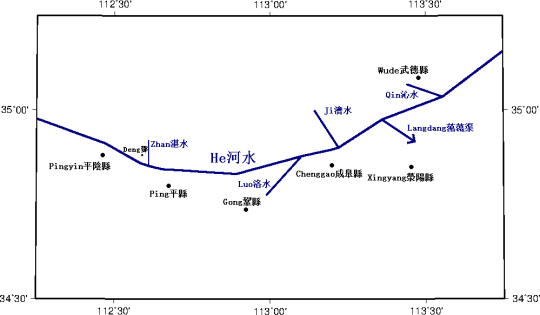
Again east it arrives at Deng鄧.
SJZ05
Again east it passes north of Ping County平縣, Zhan River湛水 comes from the north to pour into it, again east to pass north of Gong County鞏縣, Luo River洛水 from west of the county flows north to pour into it, again east it passes north of Chenggao County成臯縣, Ji River濟水 comes from the north to pour into it, again east to pass north of Xingyang County滎陽縣, Langdang Canal蒗蕩渠 sets out from there, again north-east to pass east of Wude County武德縣, Qin River沁水 comes from the north-west to pour into it
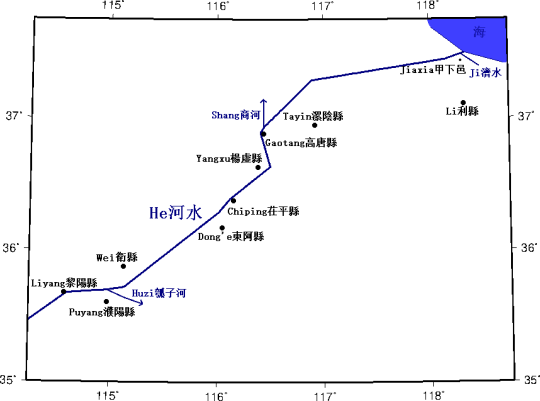
Again north-east to pass south of Liyang County黎陽縣, again north-east to pass south of Wei County衛縣, again north-east to pass north of Puyang County濮陽縣, the Huzi He瓠子河 sets out from there, again north-east to pass north of Dong'e County東阿縣, again north-east to pass west Chiping County茌平縣, again north-east to pass east of Gaotang County高唐縣, again north-east to pass east of Yangxu County楊虛縣, the Shang He商河 sets out from there, again north-east to pass north of Tayin County漯陰縣, again north-east it passes north of Li County利縣, again north-east it passes Jiaxia Town甲下邑, Ji River濟水 comes from the west to pour into, again north-east it enters the sea.
[According to the Commentary, and the Atlas, the Ji River entered the sea separate from the He.]

Fen River汾水 sets out from Guancen Mountain管涔山 north of Taiyuan's太原 Fenyang County汾陽縣, goes south-east to pass east of Jinyang County晉陽縣, Jin River晉水 flows from south-east of the county to pour into, again south Dongguo River洞過水 comes from the east to pour into it, again south to pass east of Pingtao County平陶縣, Wen River文水 comes flowing from the west to pour into it, again south to pass Guanjue Ford冠爵津, again south to enter the boundaries of Hedong河東, again south to pass west of Yong'an County永安縣, and successively east of Tang City唐城, again south to pass east of Yang County楊縣, goes south-west to pass west of Gaoliang Town高梁邑, again south to pass east of Pingyang County平陽縣, again south to pass east of Linfen County臨汾縣, again bends from south of the county to flow west, again west to pass south of Changxiu County長脩縣, again west to pass south of Pishi County皮氏縣, again west to arrive north of Fenyin County汾陰縣, and to the west pour into the He河.

Kuai River澮水 sets out from Gao Mountain 高山 east of Kuaijiao澮交 east of Hedong's河東 Jiang County絳縣, to the west passes south of that county, again south-west to pass south of Siqi Palace虒祁宮, again west to arrive at Wang Marsh王澤, and pours into the Fen River汾水.
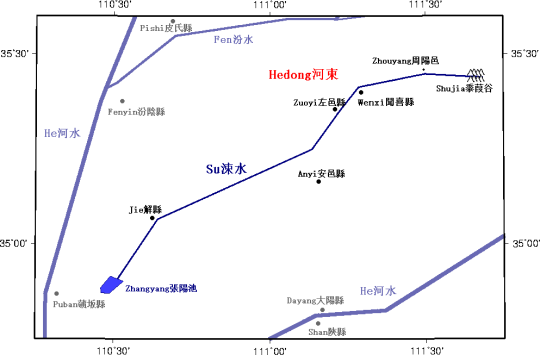
Su River涑水 sets out from Shujia Valley黍葭谷 in the mountains east of Hedong's河東 Wenxi County聞喜縣, goes west to pass south of Zhouyang Town周陽邑, again south-west to pass south of Zuoyi County左邑縣, again south-west to pass west of Anyi County安邑縣, again south to pass east of Jie County解縣, again south-west to pour into Zhangyang Pool張陽池.
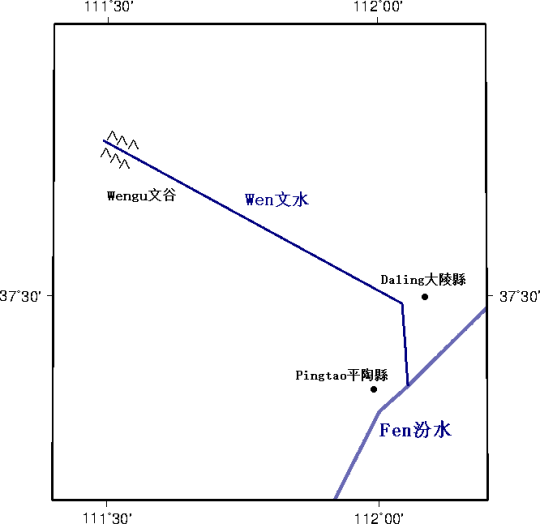
Wen River文水 sets out from Wen Valley文谷 in the mountains west of Daling County大陵縣, to the east arrives at that county, bends south to arrive north-east of Pingtao County平陶縣, and to the east enters the Fen汾.
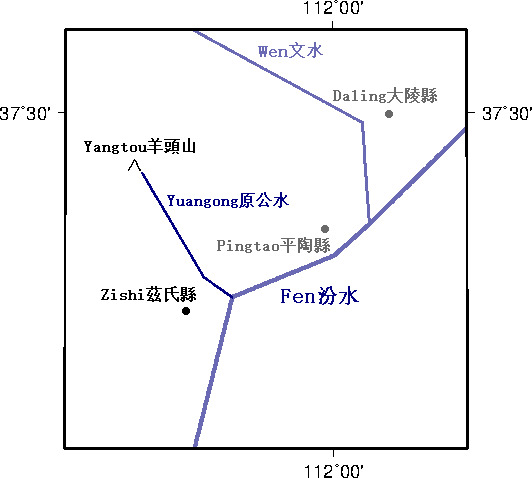
Yuangong River原公水 sets out from Yangtou Mountain羊頭山 west of Zishi County茲氏縣, to the east passes north of that county, and again east enters the Fen汾.
4 notes
·
View notes
Text
A guide to your cycling tour around Taiwan
"Peak-to-coast tours in Taiwan’s top scenic areas Island-wide bicycle excursions " "Routes for all types of cyclists Family-friendly cycling fun"
This book is published by government in 2013. so some contact information listed here may need to be updated, but the roads remain the same and hope it can be helpful for your planning before arriving at Taiwan.
Download Here: Cycling Taiwan - Great Rides in the Bicycle Kingdom
This guide introduces 26 bikeways in 12 national scenic areas in Taiwan, including 25 family-friendly routes and, in Alishan, one competition-level route. Cyclists can experience the fascinating geology of the Jinshan Hot Spring area on the North Coast along the Fengzhimen and Jinshan-Wanli bikeways, or follow a former rail line through the Old Caoling Tunnel along the Longmen-Yanliao and Old Caoling bikeways. Riders on the Yuetan and Xiangshan bikeways can enjoy the scenic beauty of Sun Moon Lake, while the natural and cultural charms of the Tri-Mountain area await along the Emei Lake Bike Path and Ershui Bikeway. This guide also introduces the Wushantou Hatta and Baihe bikeways in the Siraya National Scenic Area, the Aogu Wetlands and Beimen bikeways on the Southwest Coast, and the Round-the-Bay Bikeway at Dapeng Bay. Indigenous culture is among the attractions along the Anpo Tourist Cycle Path in Maolin and the Shimen-Changbin Bikeway, Sanxiantai Bike Route, and Taiyuan Valley Bikeway on the East Coast. Visitors can also explore the East Rift Valley via an extensive cycling route network formed by the Ruisui Bicycle Path, Dapo Pond Bikeway in Chishang, Yuli Bikeway, Liyutan Bikeway, Guanshan Town Encircling Bicycle Path, and Longtian Bike Path, or experience the offshore-island charms of Penghu along the Magong City and Huxi bikeways.
http://www.bikingtaiwan.com/
1 note
·
View note
Photo

2 notes
·
View notes